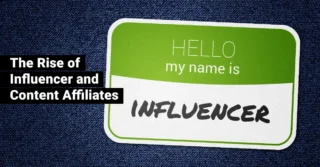As a trusted source, the customer has a higher likelihood to try something new – especially with a cashback feature. There is a built-in affinity for Rakuten, Honey and other cashback sites enabling both new and repeat purchase.
Affiliate marketing is a 20+ year practice that continues to innovate. Starting in 2021, we saw consumers shifting their online surfing loyalty from brands to affiliates. Before we go into that, let’s look at today’s economic trends.
We’ve all seen the headlines. As financial experts and elected leaders attempt to steer the economic ship, prices are going up. On November 2, the Federal Reserve increased rates for the 4th time, this time by three-quarters of a point. Research firm IRI released a report citing the increases in grocery staples, along with how consumers are opting for private labels. More time at home and dining in means more scrutiny on the overall household bill, from groceries to other everyday staples. Grocery stores, as an example, are providing additional options for shopping, increasing loyalty from their everyday shoppers. Aldi just announced that it will price their Thanksgiving items back to 2019 prices.
Loyalty doesn’t start and stop with grocery stores or other brick and mortar businesses. Popular websites that advertise retailer products and services are gaining more market share and consumer interest. But in today’s world of online shopping, loyalty is shifting from the brand to publishers (aka affiliates) that built either incentives and/or trust with its digital community.
Let’s explore.
A Kickback for your Wallet
Consumers have their favorite jeans, makeup, shoes or tech gadgets. Whether it’s shopping for a staple or a want, the internet offers shoppers countless ways that they can not only shop, but be rewarded for digitally swiping those credit cards. Websites that once had obscure one-word names are now competing with awareness through large advertising budgets. Once labeled ‘eBates’, Rakuten is now part of online shopper’s vocabulary. Starting with the clever ads on how to actually pronounce RAKUTEN to this year’s Superbowl spot and podcast ads, consumers are well informed on the notion of visiting Rakuten, finding their favorite brand, shopping and earning cash back. Another popular shopping site, Ibotta, has its logo on the New Orleans Pelicans basketball team. Before you question the idea of the value of repeat visitors, there’s more. These same consumer favorites assist with discovering new brands.
Affiliate Loyalty Sites Assist with Discovery
Sites like Rakuten and Coupon Cabin (the site has a popular cashback feature) are today’s version of the MSN or Yahoo! homepage. Remember those days? You’d visit your favorite digital community and click around. From weather to news … one stop surfing! Today’s shoppers, especially in the height of Q4, have their go-tos, visiting those sites or clicking on an email as a way to discover new brands. As a trusted source, the customer has a higher likelihood to try something new, especially with a cashback feature. There is a built-in affinity for Rakuten, Honey, and other cashback sites enabling both new and repeat purchase.
Shoppers have their go-tos for their purchases, but there is a larger website category drawing more and more traffic as consumers streamline their information resources. These sites are part of a fast growing category of affiliates (aka publishers) and continue to be the initial source of interest and education for various products and services.
News With a Dose of Household Tips
How do you take in your digital news? iPad app? Mobile device? TikTok snippets? Whichever outlet you read, I’m sure the habit took a while to develop. You may have grown accustomed to a specific beat writer or columnist. Over the years, your trust in and affinity for the outlet stuck. It became your daily source for news and information. This digital traffic was once a consistent revenue source for the property. But times shifted. Online marketing rules have changed. Privacy changes from Google and Facebook pushed that 1×1 pixel out the window. Targeting capabilities changed and those same news outlets can’t create the same revenue streams they once did.
But one thing remains the same: your daily click. Your user session. Your visit.
Mass media publishers are quickly incorporating Commerce Marketing into their business models. Appearing like an article, and labeled as a different division of the holding company, commerce marketing allows specific products to link out to a brand site. When a purchase takes place, the site takes a percentage of revenue. Sound familiar? Psst: this is the foundation of traditional affiliate marketing.
Why not take the loyal traffic and trust of online readers and provide other suggestions and ideas? Review on backpacks. Top computers to purchase. The best blenders to buy. Name the listicle and I’m sure it exists.
These Commerce divisions are offshoots of the Editorial staples like The New York Times and The Wall Street Journal. Some examples:
- NYT -> Wirecutter
- The Wall Street Journal -> Buy Side
- Forbes -> Forbes Vetted
- The Daily Beast -> Scouted
There is a strong possibility that the website visitor discovered a product or idea while scrolling through their mobile device. How many times have you been in line for coffee or paying for groceries? If you weren’t scrolling through your news app/source, you have been doing something else, like sifting through your Instagram and TikTok feeds. Enter the next category of the consumer’s shopping journey: influencers.
TikTok Made Me Do It
Come on, admit it. You are going to try that ‘Marry Me Chicken’ recipe you saw on TikTok last night. Perhaps you’ll make that famous celebrity salad you saw on Instagram reels. Or, you saved a video that your friend sent along yesterday. The holiday dress you were looking for is being reviewed by your newest Fashionista Influencer. You love their take on budget fashion so you added them to your daily scroll.
The idea of influence isn’t new. Just as mass media publishers are incorporating a performance marketing model into their revenue streams, so are influencers. The days of large flat fee campaigns are dwindling and brands are using various payment methods to ensure that their brands are at the top of the awareness set. Influencers are being starred, saved, and followed because their audiences trust something about their content. Whether it’s a comedic take on daily life or spot-on takes with drugstore beauty, trust and loyalty is built-in. It’s the kind of loyalty that most major brands pay millions of dollars to achieve.
The Common Factor
Whether it’s earning cash back on a suit, discovering the #2 rated lawnmower or mimicking the closet of a Fashion Maven, today’s tech heavy consumer isn’t starting their journey at Brand X. As companies delve deeper into Q4 activities, it’s vital to arm affiliates with the latest content, creative and promotions behind WHY consumers should use their products over others. Real estate will be tight and slotting fees are the norm. This is the new world.
Brands that are able to adapt quickly will be able to achieve something that is a constant moving target: first person customer data. Ideally, better targeting and contextual marketing will come next. Until then, we recommend trusting your affiliates to be that extended sales force, putting your product in front of engaged consumers. In our experience, affiliate marketers have been the most nimble and agile as it relates to using the latest technology and resources to build online relationships.






